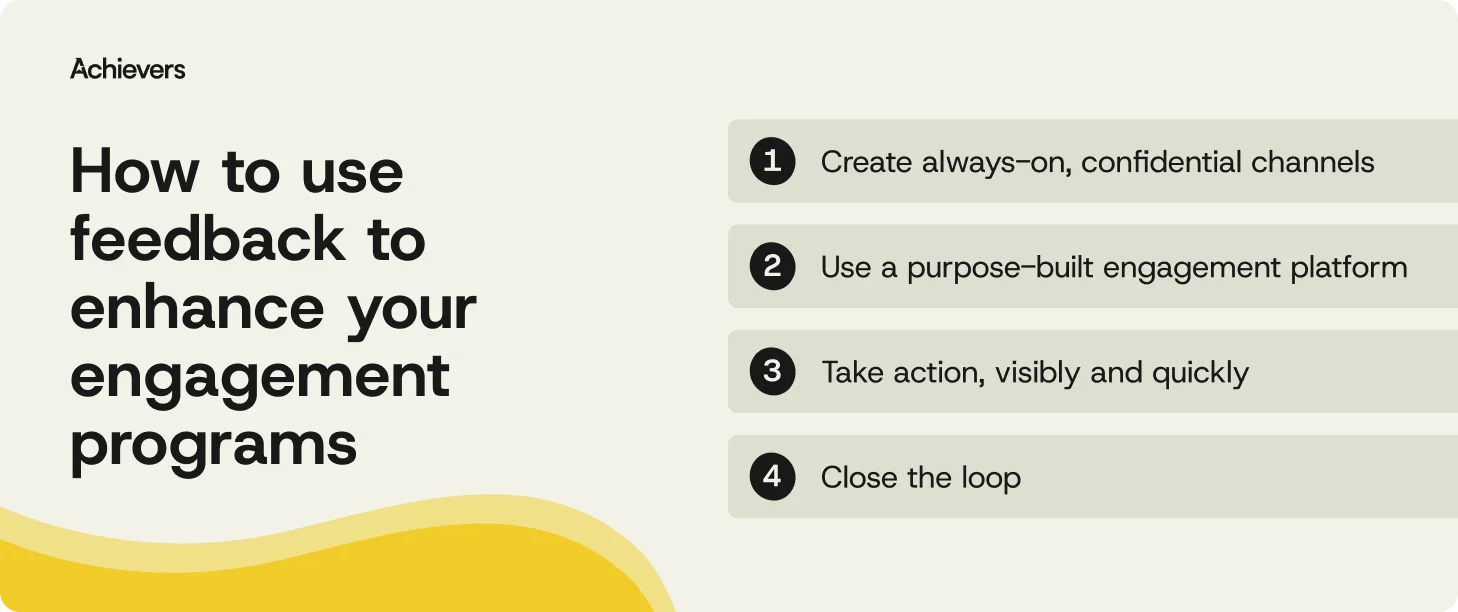Table of contents
Create a culture that means business™
Schedule a demo with an Achievers solution expert today.
Employee engagement programs sit at the heart of every great culture. Why? Because when employees feel seen, heard, and appreciated, everything else — performance, retention, collaboration — gets better. In 2026, that’s not just a belief. It’s a key business strategy. Especially when data from the Engagement and Retention Report tells us that culture is one of the top reasons employees choose to leave their current companies.
And with greater expectations shifting across hybrid and frontline teams, organizations aren’t just creating engagement programs — they’re building environments where recognition flows, purpose feels clear, and people know the work they do matters.
Ready to shape your workforce? Let’s look at 14 standout program ideas built to fuel belonging, boost morale, and drive real results.
14 employee engagement program examples for 2026
Today’s workforce expects more. More purpose, more connection, more recognition. And in 2026, the best-run organizations aren’t just reacting to that shift — they’re embracing it. They’re shaping their cultures around what truly matters to employees: being seen, heard, and appreciated.
From rewards and recognition to mentorship and flexibility, these 14 employee engagement programs are designed to align values with behaviors and turn everyday moments into meaningful impact:
1. Recognition programs
Employee recognition one of the most effective tools you have to shape culture and performance. When employees are regularly recognized in real time for living company values and driving results, engagement soars. Whether it’s peer-to-peer shoutouts, leadership awards, or social recognition in the flow of work, recognition fuels performance, retention, and culture. The most successful organizations use employee recognition programs to recognize more — and see more in return.
2. Points-based rewards
Rewards work best when they actually matter to the person receiving them. A points-based system makes that possible by giving employees the freedom to redeem for what’s meaningful to them — whether it’s an experience, something practical, or a little treat they’ve had their eye on. It’s simple, scalable, and surprisingly powerful.
3. Employee volunteer programs
Giving employees the opportunity to give back connects purpose to performance. Volunteer days, cause-based campaigns, and donation matching empower employees to make a difference beyond their day-to-day roles. The result? A stronger sense of belonging, pride, and cultural alignment — and a more engaged workforce.
4. Flexible work arrangements
Flexibility in the workplace is what helps employees get their best work done. Whether it’s hybrid work, flexible hours, or compressed schedules, giving your people control over when and how they work boosts well-being, autonomy, and trust. Companies that lead with flexibility see higher engagement and lower burnout because they’re putting people first.
5. Mentorship opportunities
Growth drives engagement. Mentorship programs connect employees with trusted guides who help them navigate challenges, build skills, and map out career paths. These relationships increase confidence, strengthen internal networks, and reinforce a culture of learning and support.
6. Team-building activities
Team building doesn’t have to mean awkward icebreakers. Think shared challenges, team lunches, community projects, or ERG-led activities that help people connect like humans, not job titles. These moments turn colleagues into collaborators — and culture into something people genuinely feel part of.
7. Wellness programs
Wellness is more than yoga mats and a discount at the local gym. Modern programs support physical, mental, and emotional well-being — whether through mindfulness resources, coaching, or wellness challenges. When employees feel genuinely cared for, engagement becomes a whole lot more natural.
8. Charity work
Values-led companies inspire values-led employees. Through charitable giving campaigns, fundraising events, and social impact initiatives, employees rally around shared purpose. That connection strengthens culture, deepens engagement, and shows that your organization walks the talk.
9. Onboarding programs
First impressions matter. An engaging onboarding experience builds connection from day one — helping new hires feel equipped, welcomed, and excited to contribute. Structured onboarding that combines training, cultural immersion, and mentorship lays the foundation for long-term engagement and success.
10. Employee resource groups (ERGs)
Belonging fuels engagement. ERGs create space for employees to connect, share, and advocate for each other. From professional development to culture-building events, ERGs elevate underrepresented voices and drive inclusive excellence — turning diversity into a business strength.
11. Employee voice and feedback loops
If you want better engagement, ask employees what they need — and then do something meaningful with the answers. Regular check-ins, pulse surveys, and always-on channels give employees space to speak up. Transparent follow-through shows them you’re listening. Nothing builds trust faster than closing the loop.
12. Clear career pathways
Most employees aren’t asking for a crystal ball — just a little clarity. Transparent career pathways show people how to grow, what skills they need, and what success actually looks like. When progression isn’t a mystery, employees stop guessing and start investing. It’s good for their future — and great for yours.
13. Formal award programs
Done right, award programs create structure and excitement. Think Employee of the Month, service milestones, or culture champion awards — all anchored to real values and real impact. These programs bring consistency to recognition and give your people something to look forward to (other than lunch).
14. Flexible work and meaningful time off
Flexibility is no longer a perk — it’s a baseline. Hybrid options, flexible hours, compressed weeks, and strong PTO policies help employees manage life without burning out. Add paid volunteer time off (VTO) and you get the holy grail of engagement: people who feel trusted, balanced, and proud of where they work.
How to turn feedback into engagement fuel
Feedback isn’t just a listening exercise — it’s your blueprint for action. When employees see their voices drive real change, trust deepens and engagement grows. Employees don’t expect perfection — but they do expect to be heard. Show them their feedback matters, and they’ll show up more engaged, aligned, and ready to contribute.
Here’s how leading organizations are turning employee voice into a force for stronger, more responsive cultures:

Create always-on, confidential channels
From employee survey questions to digital suggestion boxes and HR chatbots, feedback should be easy, accessible, and safe to share. Offering multiple confidential touchpoints shows employees their input is welcome anytime — not just during an annual review.
Use a purpose-built engagement platform
Don’t just collect data — connect the dots. A modern employee engagement platform brings together surveys, sentiment analytics, and feedback history to uncover what’s really driving engagement (or holding it back). That insight empowers leaders to act fast and with precision.
Take action, visibly and quickly
Nothing builds disengagement faster than ignored feedback. When employees raise concerns — whether it’s workload, team dynamics, or resource gaps — respond with clarity, empathy, and urgency. Action, not acknowledgment, drives culture change.
Close the loop
Transparency earns trust. Share what you heard, what you’re doing about it, and why. Whether it’s launching new training, updating a policy, or adding resources, clear communication turns feedback into a shared success story.
What makes an employee engagement program successful?
Launching engagement programs is only half the equation. Sustaining them? That takes intention, alignment, and a culture that puts people first. Because when the right environment supports the right initiatives, employees don’t just show up — they show up inspired, connected, and ready to contribute.
Here are eight must-haves that turn good programs into great outcomes:
- Clear, human communication: Open, consistent communication keeps everyone aligned and builds trust from the inside out. Whether it’s pulse surveys, all-hands updates, or one-on-one check-ins, people want to feel informed, heard, and valued.
- A mission employees can see themselves in: Employees thrive when they feel connected to something bigger than themselves. A clear purpose and strong values turn everyday tasks into meaningful contributions — and foster a culture of shared momentum.
- Accountability that empowers growth: High-performing cultures set clear expectations, provide regular feedback, and celebrate progress. When employees know how their work is measured — and are supported along the way — they stay motivated and focused.
- Recognition that’s frequent and meaningful: Recognition isn’t a box to check. It’s a behavior-shaping tool that drives productivity and performance, culture, and retention. When employees feel seen and appreciated — by peers, leaders, and teams — they engage more and stay longer.
- Leadership that lifts: Strong leaders lead with empathy, recognition, and clarity. They model the behaviors they want to see and create space for others to grow. The best leaders build trust — and cultures that scale it.
- Continuous development: Whether it’s mentorship, upskilling, or stretch assignments, opportunities to grow signal that employees matter — now and in the future. That investment builds loyalty and keeps top talent engaged.
- Culture that creates belonging: Engagement thrives in environments where people feel safe to speak up, take risks, and bring their whole selves to work. A strong culture isn’t just a vibe — it’s a competitive advantage.
- Purpose-driven impact: Employees care about what their company stands for. Programs that support community involvement, sustainability, and ethical practices create pride and meaning — far beyond the job description.
The business impact of employee engagement
Employee engagement isn’t just about morale — it’s about momentum. When employees feel recognized, connected, and supported, they do more than show up. They lean in, speak up, and go further. That’s why the world’s best-run businesses don’t just invest in engagement — they build cultures around it.
Here’s what that looks like in action:
- Higher productivity: Engaged employees are energized employees. When individuals feel seen, supported, and aligned with your values, they’re more focused, efficient, and motivated to go the extra mile — not because they have to, but because they want to. Companies with highly engaged employees experience a 21% increase in profitability, highlighting the direct link between engagement and financial performance.
- Stronger company culture: Recognition, communication, and purpose are the pillars of a thriving culture. Programs that reinforce those key elements help create environments where employees feel valued, included, and excited to be a part of your organization for the long haul.
- Increased retention: Employees stay when they feel heard, recognized, and supported. A robust engagement strategy — grounded in feedback, growth, and appreciation — transforms talent into long-term contributors. Organizations with high employee engagement see a 59% reduction in turnover in low-turnover companies and 24% in high-turnover companies.
- Better collaboration: From Employee Resource Groups (ERGs) to volunteer initiatives and team-building events, engagement programs strengthen relationships across the organization. This fosters more trust, better teamwork, and greater cross-functional impact.
- Improved well-being: Engagement and well-being go hand in hand. Flexible work arrangements, mental health resources, and wellness support demonstrate that you’ve got your employees’ backs — in and out of the office. Organizations promoting work-life balance see a 25% increase in employee engagement.
- Stronger alignment with company vision: When employees understand how their work connects to the bigger picture, motivation follows. Engagement programs help make that connection clear — translating purpose into performance.
- More innovation and growth: Engaged employees don’t wait to be told — they take initiative. They bring ideas, pursue opportunities, and invest in learning. This spirit of ownership fuels innovation and drives long-term growth. Highly engaged business units are 21% more profitable.
- Higher customer satisfaction: Happy teams create happy customers. When employees are empowered and engaged, it reflects in every interaction — building trust, loyalty, and a memorable brand experience. Engaged employees contribute to a 10% increase in customer ratings.
Shape a culture where engagement drives results
As we move into 2026, the most successful organizations aren’t just checking the box on engagement — they’re leading with it. They’re building cultures rooted in recognition, flexibility, growth, and shared purpose. Because when employees feel seen, supported, and aligned, they don’t just show up — they show up ready to achieve.
At Achievers, we help organizations turn engagement into lasting impact. With a platform built for frequent recognition, global scalability, and measurable results, we give you the tools to shape your workforce — one meaningful moment at a time.
Ready to build a workplace where people thrive and performance follows? Let’s do it together.



